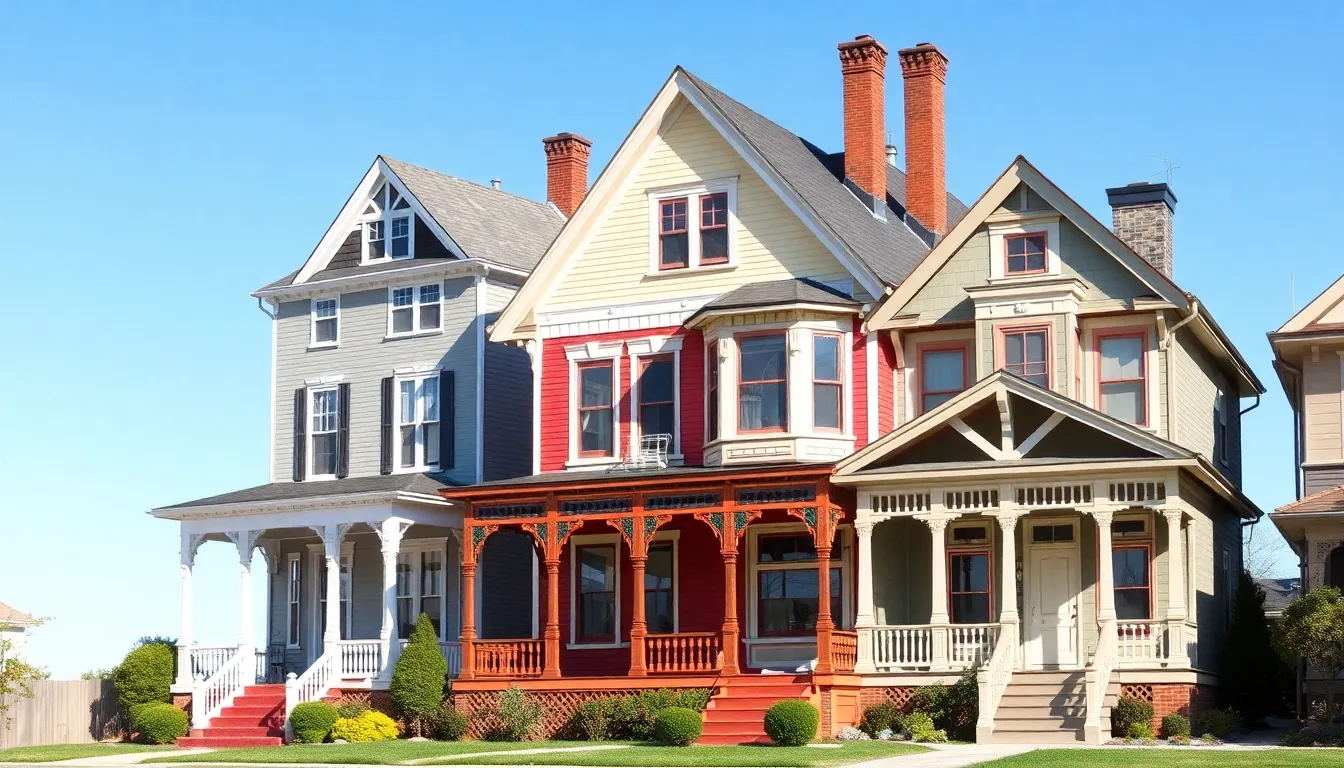Step into the world of historic homes, where every creaky floorboard tells a story and every faded wallpaper whispers secrets from the past. These architectural gems don’t just house memories; they’re time capsules waiting to be explored. From grand mansions to cozy cottages, each one offers a glimpse into a different era, complete with its own quirks and charm.
Table of Contents
ToggleOverview of Historic Homes
Historic homes represent significant architectural styles and periods, each with unique features. These residences typically reflect the cultural and historical context of their times, serving as windows into the past. From Colonial to Victorian, various architectural movements highlight differing design philosophies.
Many historic homes serve as museums or local landmarks, attracting tourists interested in heritage and craftsmanship. Preservation efforts help maintain their original character, allowing visitors to experience authentic architectural elements. Restoration projects often focus on key aspects, such as woodwork, roofing, and landscaping.
Architectural styles vary widely among historic homes. Georgian homes, for instance, boast symmetrical facades and classical details. In contrast, Arts and Crafts homes emphasize handcrafted materials and simplicity, showcasing a more relaxed aesthetic. Each style narrates a story about the people who lived and worked in these spaces.
Some historic homes feature innovative technologies for their time. They might include early plumbing systems, heating methods, or advanced construction techniques. These elements provide insights into the evolution of residential design.
In addition to architectural significance, many historic homes hold social and cultural importance. They often tell stories of the communities in which they exist, including the lives of influential individuals. Historic homes can represent movements, such as the suffrage movement or civil rights, reflecting societal changes over time.
Exploration of historic homes offers a chance to appreciate craftsmanship and design while understanding their role in shaping history. Visitors often engage with these spaces, connecting with the narratives embedded in their walls.
Architectural Styles of Historic Homes

Historic homes showcase a variety of architectural styles, each embodying unique characteristics and stories. They reflect the cultural values and technological advancements of their respective periods.
Colonial Era
Colonial homes exhibit symmetry and simplicity, often made from wood or brick. These structures typically feature gabled roofs and central front doors, creating a classic appearance. In New England, Colonial homes often include large chimneys, providing warmth and comfort during harsh winters. Southern Colonials display expansive porches and columns, reflecting influences from tropical climates and European designs. This diversity within the Colonial style captures the essence of the early settlers’ lifestyles and the resources available in their regions.
Victorian Era
Victorian homes are known for their intricate details and vibrant colors. Architectural elements like steep roofs, decorative trim, and bay windows define the style. Often, these residences include unique asymmetrical shapes, showcasing an embrace of individuality during the late 19th century. The texture-rich materials, such as stained glass and patterned wallpapers, also contribute to their charm. While popularized in urban settings, Victorian homes tell stories of wealth, innovation, and societal shifts during the Industrial Revolution.
Craftsman Style
Craftsman homes emphasize handcrafted artistry and natural materials. This style prioritizes functionality while promoting a connection to nature through overhanging eaves and exposed beams. Built-in furniture, wide porches, and extensive woodwork create inviting living spaces. The use of earth tones in exterior finishes further enhances the harmony with the environment. Craftsman homes often reflect the Arts and Crafts movement’s values, mixing comfort with artistry, appealing to those valuing craftsmanship and simplicity while seeking aesthetic beauty.
Preservation and Restoration
Preservation and restoration play crucial roles in maintaining historic homes. These efforts ensure that architectural heritage remains intact for future generations to appreciate.
Importance of Preservation
Preservation protects the historical integrity of properties. Historic homes serve as tangible connections to the past, reflecting the cultural fabric of their time. They offer educational opportunities and foster tourism, enhancing local economies. Original features, like decorative moldings or stained glass windows, convey craftsmanship and artistry, showcasing specific architectural styles. Through preservation, communities can celebrate their heritage, instilling a sense of pride among residents.
Techniques for Restoration
Restoration techniques vary based on the home’s condition and historical significance. Craftspersons often use traditional methods to restore authenticity. Techniques include repairing damaged woodwork and matching paint colors to original samples. Specialists may also recreate missing elements, like cornices or trim, using sustainable materials that respect the home’s period. Efforts focus on preserving structural integrity while modernizing aspects to meet current building codes. It’s essential to document each restoration phase, ensuring transparency and educational value for future projects.
Notable Historic Homes to Visit
Exploring notable historic homes offers a glimpse into the past and highlights unique stories and architectural marvels. Visitors can appreciate both famous landmarks and charming hidden gems.
Famous Examples
Mount Vernon, the plantation home of George Washington, encompasses beautifully preserved gardens and rich history. Another iconic site, Graceland, showcases Elvis Presley’s life and music, drawing fans from around the world. The Winchester Mystery House in California captivates visitors with its unusual architecture and intriguing history. Monticello, Thomas Jefferson’s estate, features neoclassical design and reflects his ideals. Lastly, the Hearst Castle in San Simeon, a sprawling estate, showcases opulence and artistic collections that impress countless tourists.
Local Hidden Gems
In addition to well-known sites, numerous hidden gems await discovery. The Gamble House in California offers visitors a look at Craftsman architecture and interior design. The Paul Revere House in Boston, one of the oldest structures in the city, provides a glimpse into colonial life and patriot history. Now designated a historic landmark, the Frank Lloyd Wright Home and Studio in Illinois showcases the architect’s groundbreaking designs. Another treasure is the Old Stone House in New York, which highlights the city’s revolutionary history and architectural evolution. These lesser-known homes enrich the cultural landscape and often provide more intimate experiences.
Challenges in Historic Home Ownership
Historic home ownership presents unique challenges. Homeowners face various aspects that require careful consideration.
Maintenance Issues
Old materials often require special care. Wood, plaster, and historically accurate paint all need attention to maintain a home’s original character. Repairing or replacing these materials can prove costly. Homeowners often find that sourcing authentic materials is challenging, as some are no longer manufactured. Regular inspections of roofs, foundations, and plumbing are essential to avoid future damage. Aging systems like electrical wiring may not meet modern safety standards, necessitating updates for safety compliance.
Historic Regulations
Regulations often accompany owning a historic home. Local preservation statutes may restrict modifications to maintain a property’s historic integrity. Homeowners may need permits for renovations, especially if altering exterior features. Understanding the rules governing restoration projects can be complex, requiring guidance from local preservation boards or committees. Compliance with these regulations may limit choices in design and materials, making some modern conveniences difficult to integrate. Balancing adherence to regulations with personal preferences adds another layer of complexity to ownership.
Historic homes are more than just structures; they’re living pieces of history that offer a glimpse into the past. Each home carries its own unique narrative and reflects the artistry of its time. The commitment to preserving these architectural treasures ensures that future generations can continue to learn from and appreciate their significance.
As visitors explore these homes, they not only admire the craftsmanship but also connect with the stories of the people and communities that shaped them. Whether famous landmarks or hidden gems, these residences enrich our cultural landscape and inspire a deeper understanding of our heritage. Embracing the charm and history of historic homes fosters a sense of pride and responsibility in preserving these invaluable assets for years to come.



